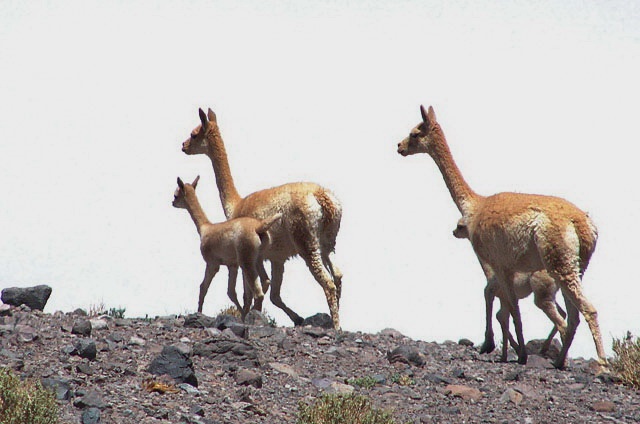Why vicuñas create communal dung piles
Vicuñas live in arid, cold and barren areas, high in the Andes. They set up permanent places to defecate and urinate and use those latrines for decades. There is disagreement about why.
High in the South American Andes, where the soil is arid, rocky, and barren, some places stand out because they are green, overgrown with plants. The greens islands developed because vicuñas come there repeatedly to defecate and urinate. Why do they use such latrines? To create gardens with plants that they can feed on, Kelsey Reider and Steven Schmidt suggest. No, the dung piles are kind of nameplates that mark their territory, William Franklin thinks.
Unpalatable bunch grass
Vicuñas are one of the few animal species that live in the Andes at altitudes of more than 4000 meters, right up to the edge of snow. They mainly live in groups that roam over a territory of almost 20 square kilometers. Climate change is also noticeable here; glaciers dwindle and retreat to the mountain tops. Where they melt, a bare bottom appears which is poor in plant nutrients, so that it takes decades before a noteworthy vegetation is formed. Vicuñas are the first to enter the newly exposed soil at the edge of the glaciers.
With their droppings, they enrich the soil with nutrients. They defecate and urinate only on permanent latrines or dung piles which persist for decades. Consequently, fertilized places are created where vegetation can develop more quickly.
First, a vegetation appears that is dominated by the tough and little nutritious Peruvian feather grass, Stipa pichu. It is not until hundreds of years later that a grassier vegetation develops, with the grass Calamagrostis vicunarum, other grasses and herbs.
Peaceful
In those grassy places vicuñas forage preferentially. Because the places are still used as latrines also, the animals run the risk of picking up gastrointestinal parasites. But places with tasty vegetation are so scarce that it is worth the risk.
That is why Reider and Kelsey believe that the vicuñas maintain latrines in order to concentrate their dung and accelerate the development of nutritious vegetation locally. In other words, latrines are gardens where they grow food.
Franklin thinks otherwise, however. Vicuñas that use a young latrine at the edge of a glacier or start a new one will not be able to enjoy a tasty yield themselves, because generations will have passed before there will grow anything edible. When it comes to food breeding, it would be better for an animal to choose an older latrine where plant growth is already substantial.
Instead, he thinks that the dung piles mark the territory of a group. This is important because if an animal enters another group’s territory accidently, it will be violently attacked and chased away and is at risk of serious injury. By marking the territory at fixed places with the characteristic group scent, especially at the borders, a group manages to keep its members within their own safe territory. So, at a border, two groups may be seen peacefully grazing side by side, each in its own area.
Side-effect
Every group member contributes to these scent markings, and whoever contributes benefits from the fact that the nameplate is maintained.
As a result, vegetation develops on bare ground, gradually becoming more attractive. Which is a nice side-effect for future generations and other mammals that visit the grassy places: mountain viscacha (Lagidium viscacia) and Andean fox (Lycalopex culpaeus).
Willy van Strien
Photo: Dick Culbert (Wikimedia Commons, Creative Commons CC BY 2.0)
Sources:
Franklin, W., 2021. Vicuña dung gardens at the edge of the cryosphere: Comment. Ecology 102: e03522. Doi: 10.1002/ecy.3522
Reider, K.E. & S.K. Schmidt, 2021. Vicuña dung gardens at the edge of the cryosphere. Ecology 102: e03228. Doi: 10.1002/ecy.3228
